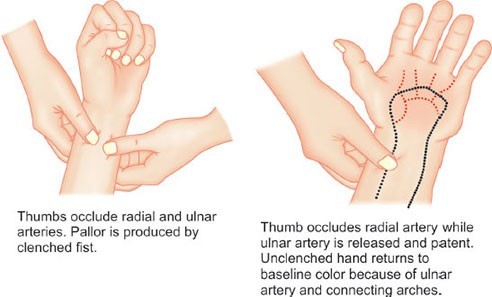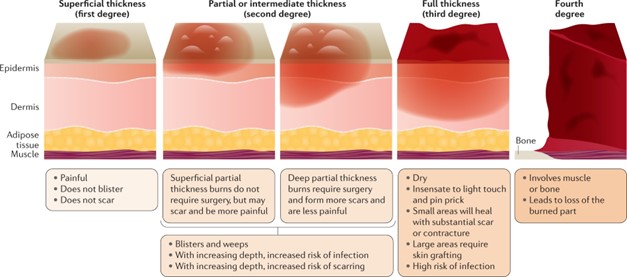When should the nurse conduct an Allen's test?
Just before arterial blood gasses are drawn peripherally.
Prior to attempting a cardiac output calculation.
To assess for presence of a deep vein thrombus in the leg.
When pulmonary artery pressures are obtained.
The Correct Answer is A
Allen's test is a procedure used to assess the patency of the ulnar artery and the collateral circulation of the hand. It is performed to determine the adequacy of collateral circulation before obtaining arterial blood gases from the radial artery. The test helps ensure that the ulnar artery is functioning properly and can supply blood to the hand if the radial artery is used for blood sampling or other invasive procedures.
The test involves occluding both the ulnar and radial arteries while the patient clenches their fist. The nurse then releases pressure on the ulnar artery while maintaining occlusion of the radial artery. The hand should quickly regain normal coloration, indicating adequate collateral circulation.
It's important to note that the Allen's test is specific to the assessment of collateral circulation in the hand and is not used for other purposes such as assessing deep vein thrombosis, cardiac output calculation, or obtaining pulmonary artery pressures.

Nursing Test Bank
Naxlex Comprehensive Predictor Exams
Related Questions
Correct Answer is C
Explanation
A) Incorrect- While physical soothing can help comfort the child after the injections, it may not significantly reduce the duration of pain during the injections themselves.
B) Incorrect- Verbal reassurance is important to provide a calming environment, but it may not directly reduce the duration of pain during the injections.
C) Correct- Administering vaccines can be distressing for toddlers due to the pain associated with injections. To reduce the duration of pain and minimize the overall discomfort, the nurse should prioritize the strategy of simultaneous injections. This involves administering multiple vaccines at the same time rather than spacing them out. The rationale behind this approach is that the child experiences the discomfort of the injections only once, which can help reduce their overall distress and anxiety.
D) Incorrect- The positioning of the child may not have a direct impact on the duration of pain during injections. However, choosing an appropriate position for comfort is still important.
Correct Answer is ["B","D","E"]
Explanation
These findings suggest potential complications and compromise to the client's circulation and nerve function, which require immediate attention.
Changes in the quality of peripheral pulses indicate alterations in blood flow and may suggest vascular compromise or decreased perfusion to the affected areas. This finding requires immediate intervention to prevent further damage and ensure adequate blood supply to the extremities.
Loss of sensation to the left lower extremity can be indicative of nerve injury or impaired peripheral nerve function. It is important to assess for nerve damage and address it promptly to prevent complications and maximize the client's recovery.
Complaints of increased pain and pressure are concerning because they may indicate the development of compartment syndrome, a serious complication in which pressure within the muscles and tissues builds up to dangerous levels. Prompt intervention is necessary to relieve the pressure and prevent tissue damage.
While sloughing tissue around wound edges and weeping serosanguineous fluid from wounds are important assessment findings in the context of burn care, they do not require immediate intervention compared to the findings mentioned above. These findings should still be addressed and managed appropriately, but they are not considered immediate emergencies.

Whether you are a student looking to ace your exams or a practicing nurse seeking to enhance your expertise , our nursing education contents will empower you with the confidence and competence to make a difference in the lives of patients and become a respected leader in the healthcare field.
Visit Naxlex, invest in your future and unlock endless possibilities with our unparalleled nursing education contents today
Report Wrong Answer on the Current Question
Do you disagree with the answer? If yes, what is your expected answer? Explain.
Kindly be descriptive with the issue you are facing.
